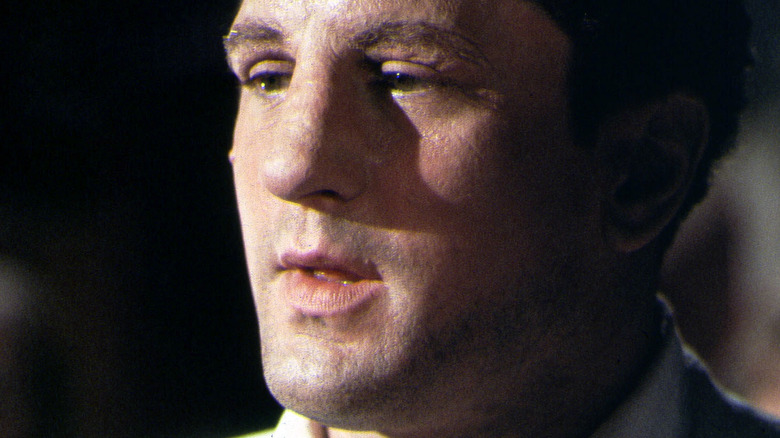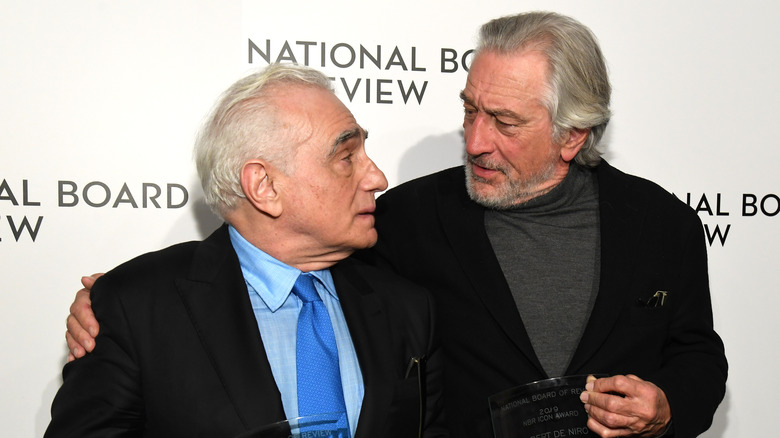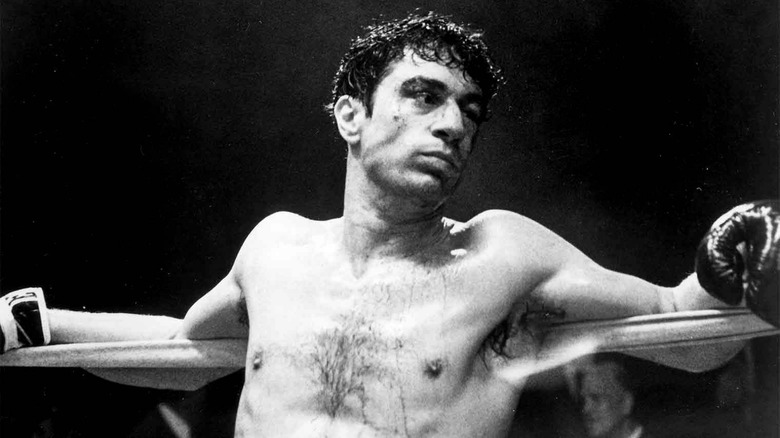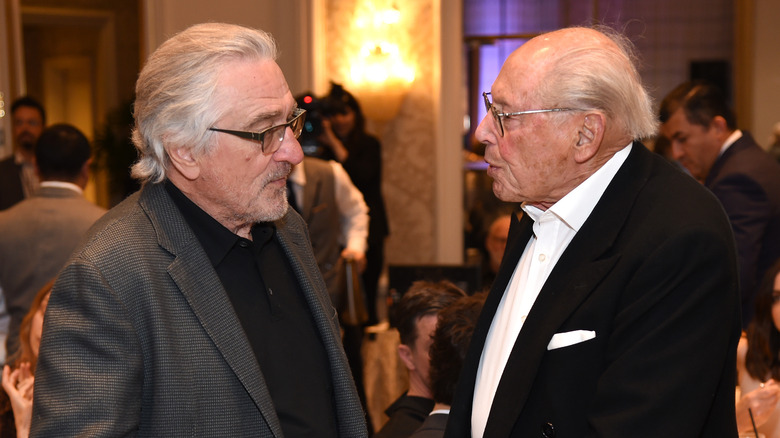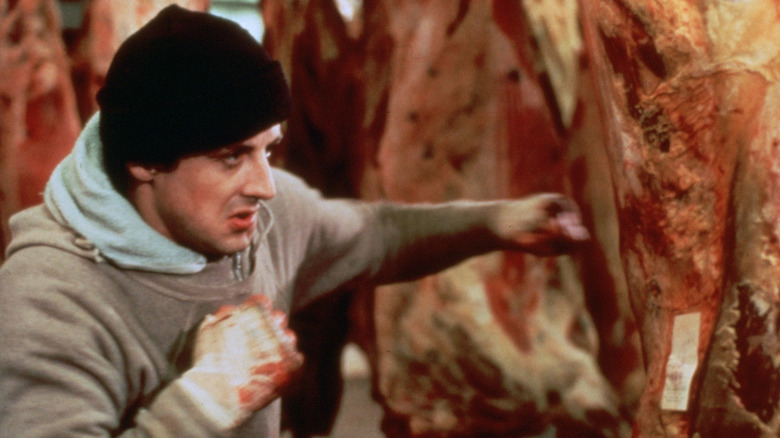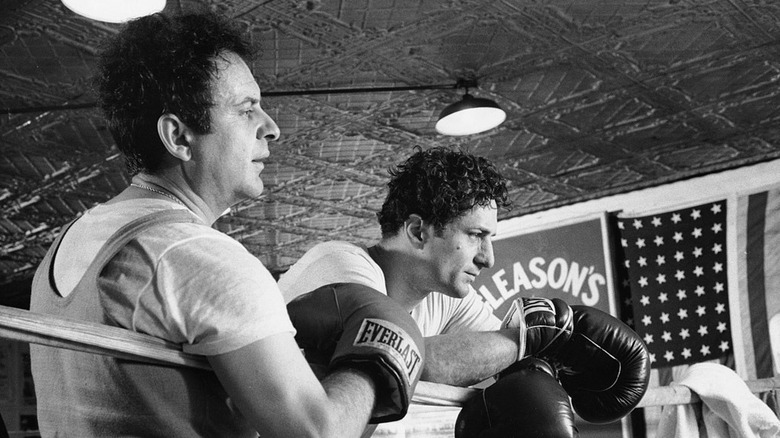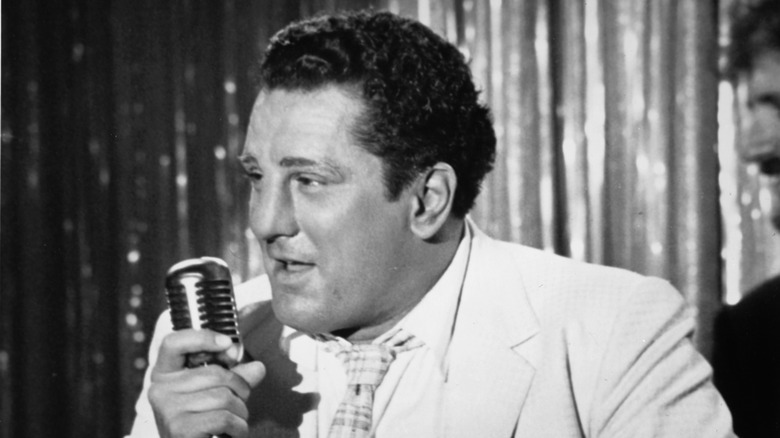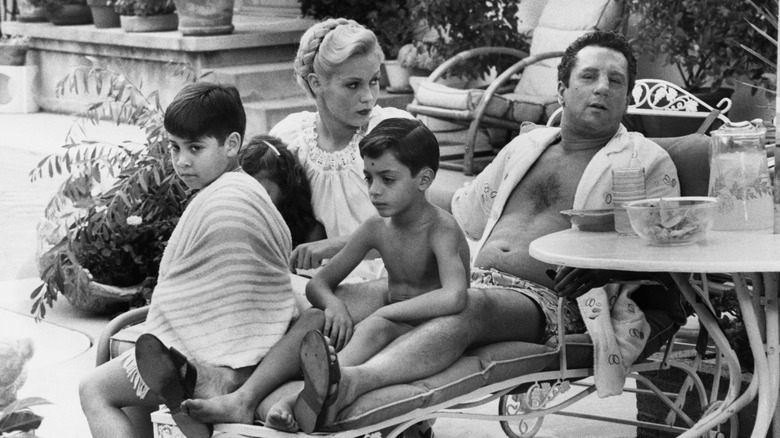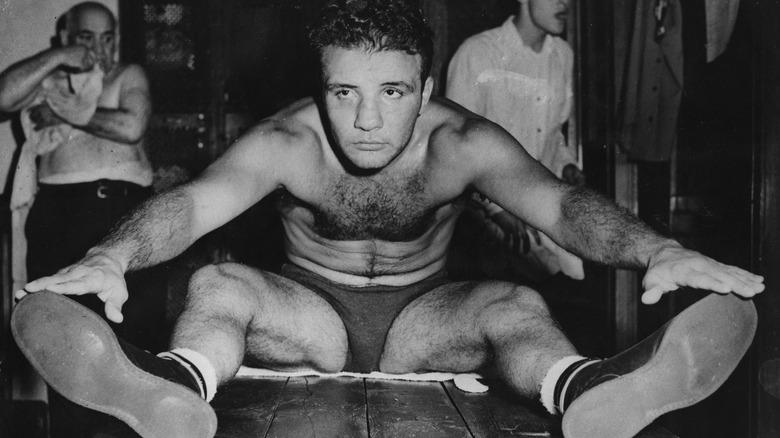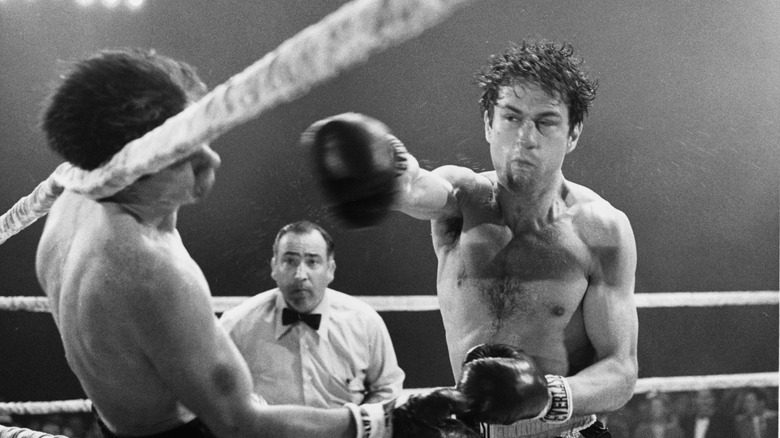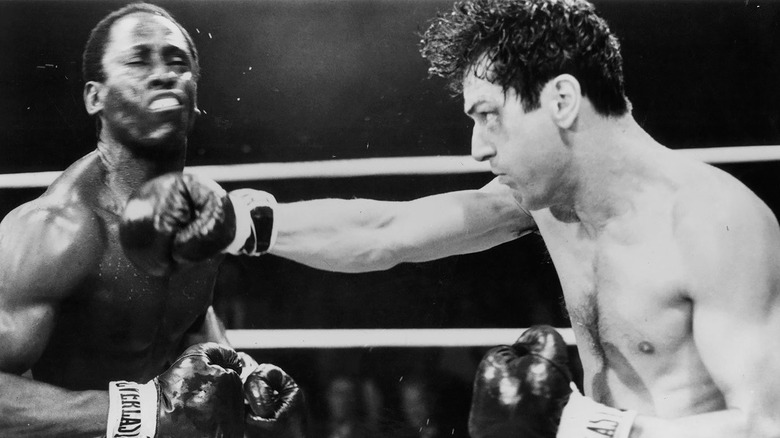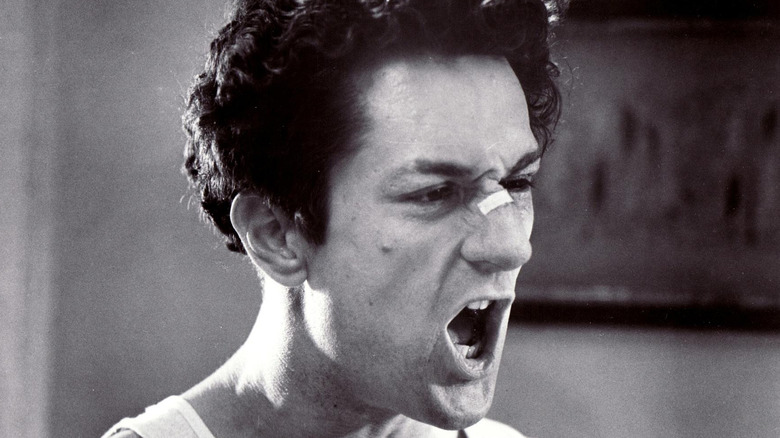Return To The Ring For Some Knockout Raging Bull Facts
All sport makes for great theatre. The all-or-nothing nature of competition, where heroes and villains can be born and reputations sealed or smashed in a split second makes for compelling viewing. The euphoric highs and terrible lows of an athlete on their journey to overcome seemingly impossible odds and win the day transcends sport and becomes a metaphor for the human spirit. "Rocky," "Any Given Sunday," and "Chariots of Fire," are all prime examples of how sport can inspire, elevate, and bring out the best in us. Martin Scorsese's "Raging Bull" on the other hand, flips this formula on its head and gives a penetrating insight into the self-destructive nature of an individual who is consumed by the same energies and motivations that initially made them such a fierce contender.
Sometimes the lives of athletes take on the scale and scope of a Shakespearean tragedy. Jake LaMotta is one such individual. The chief protagonist of "Raging Bull," played with a career-defining intensity by Robert De Niro has none of the wholesome charm, aspirational earnestness, or everyman appeal of fictional pugilists such as Rocky Balboa. LaMotta has no off switch and cannot distinguish between the man he is in the confrontational intensity of the ring and the man he is in everyday life. The fury and fire that define and make him a household name are the same elemental energies that lead to his downfall. Four decades after its release, Scorsese's masterpiece still hits like a heavyweight punch. It's a film about a boxer, but it's not about boxing. It's about a man driven by insecurity, jealousy, and the dark places it leads him. Let's return to the ring for some inside facts about "Raging Bull."
Robert De Niro and Norman Mailer helped convince Martin Scorsese to make Raging Bull
According to Vanity Fair, Martin Scorsese had no interest in boxing before the making of "Raging Bull." Movies and music, not sports had always been the director's first love. He explained, "I didn't know anything about boxing. It was always one angle on TV or in the movie theaters, where they'd show the fights on the weekend. I didn't know what the hell was going on. It was sports, which took me out of the picture." Getting "Raging Bull" made was initially Robert De Niro's obsession, and he was determined to get his friend to direct it. Yet, it was not until he was recovering in hospital from a near-fatal collapse, caused by a toxic combination of illegal and prescription drugs, that Scorsese admitted he finally began to understand De Niro's interest in such a flawed and self-destructive character as Jake LaMotta.
Norman Mailer was amongst other things, a big fan of the fight game (via The Atlantic). He once wrote, "Just as Marlon Brando seemed to inhabit a role as though it were a natural extension of his mood, so Ali treated boxing." According to Cinephilia & Beyond, in a 1981 interview with Michael Henry, Scorsese revealed that Mailer was extremely encouraging and told him, "You have to make this film" because the writer insisted that a character such as LaMotta and his relationship to the "American Dream" was the only real-life basis for many characters in his novels. Scorsese also recounted the time Mailer met LaMotta in the bar and upon hearing the author brag about how could have made it as a boxer, LaMotta simply said, "No, you're not disturbed enough."
If you or anyone you know needs help with addiction issues, help is available. Visit the Substance Abuse and Mental Health Services Administration website or contact SAMHSA's National Helpline at 1-800-662-HELP (4357).
Directing Raging Bull helped Martin Scorsese recover from a near-fatal collapse
Great art often has its origins in places of great despair, and after being rushed to hospital from a near-fatal collapse, Scorsese began to appreciate the redemptive qualities in the story arc of "Raging Bull" (via Vanity Fair). Scenes such as the one where Jake LaMotta is in a jail cell and cries out, "I'm not an animal" portray a man at his lowest, where there are only two choices: destruction or redemption. LaMotta eventually chooses the latter as did Scorsese. In an interview with Jay Glennie for "Raging Bull: The Making Of," Scorsese said, "It became more impossible for me to function, both physically and mentally, until I finally collapsed" (via The Independent). Mardik Martin, who co-wrote "Raging Bull" added that upon admission to the hospital, Scorsese was, "Bleeding from his mouth, bleeding from his nose, bleeding from his eyes."
Robert De Niro visited Scorsese in the hospital and allegedly asked, "Are you gonna be one of those directors who makes a couple of good movies, and then it's over for them?" De Niro remembered telling Scorsese that no one else on earth could make "Raging Bull" as he would. The director recalled that it was fortunate there was such a meaningful project for him to sink his teeth into. The Guardian reported that at the 2021 Tribeca Film Festival, Scorsese remembered lying in the hospital, not knowing, "If I could be inspired to make another movie," but in time came to view "Raging Bull" as a "rebirth in a way." Scorsese added, "I made it as if it was the end of my life. I didn't care if I made another movie."
Rocky Producer Irwin Winkler blackmailed United Artists to finance Raging Bull
"Rocky" and "Raging Bull" are both movies about people who live their professional life governed by Queensberry rules, but that's where all similarities end. The two movies are as different as chalk and cheese. Yet, according to Oscar-winning producer-director Irwin Winkler, one wouldn't have been made without the other. CBS News reported that in his memoir, "A Life in Movies: Stories From 50 Years in Hollywood," Winkler explained that he read Jake LaMotta's autobiography after seeing an obsessed Robert De Niro carrying it around on the set of "New York, New York." Winkler wrote, "I read the book and saw not only a fight film (we had just done 'Rocky') but a look into the soul of LaMotta and what the violence in the ring had brought to his life outside the ring." Keen to bring the book to life with De Niro starring and Martin Scorsese directing, Winkler took a script to United Artists who flat-out refused to finance the film.
United Artists executive David Fields vented his disgust for Jake LaMotta and said, "He's no better than a cockroach." Winkler reassured Scorsese and a furious De Niro that he would make United Artists see sense. Here's where it gets interesting. Winkler went straight to Field's boss and the new CEO of United Artists, Andy Albeck, and told him that if they didn't finance "Raging Bull" they could forget about "Rocky II" ever being made. "We were serious; it was not a bluff," explained Winkler. It was a fortuitous move by United Artists to throw their financial clout behind "Raging Bull" because as Winkler points out, they also got the entire Rocky franchise, including "Creed" and "Creed II."
Martin Scorsese wanted Raging Bull to be the polar opposite of Rocky
Ask anyone to name a film about boxing and nine times out of 10, they'll say "Rocky." The film that made Sylvester Stallone famous is the classic tale of the underdog made good. It oozes a passion for pugilism from its every pore and has a feel-good vibe that's hard to beat. "Raging Bull" is an altogether different beast. Partly because Jake LaMotta is based on a real-life fighter, and not a fictional construct, and partly because Martin Scorsese wanted "Raging Bull" to be the polar opposite of "Rocky." Hollywood Suite reported that comparisons between "Rocky" and "Raging Bull" were inevitable considering there was only one year between them and they were both about boxing. To distinguish his film from John G. Avildsen's, Scorsese made a few moves that United Artists weren't exactly keen on.
Making Jake LaMotta an anti-hero that the audience at times would be repulsed by, was in stark contrast to Rocky Balboa. The Italian Stallion was so loved by the people of Philadelphia, hundreds of them would join him in his early morning runs up the city's 72 steps to the Museum of Art. Secondly, by filming in black and white, you'd never mistake Scorsese's film for the contemporary color and feel of "Rocky." By filming in black and white, Scorsese felt he could get away with making the boxing scenes more authentic by adding the blood that the more sanitized "Rocky" lacks. Lastly, Scorsese didn't believe in pulling any punches when documenting a real-life warts n' all account of the violence and anger that made a man a fearsome fighter.
Raging Bull was Joe Pesci's breakthrough movie
From "Goodfellas" to "Casino," and more recently, "The Irishman," Joe Pesci has become a long-term staple of classic Martin Scorsese films, and it all began with "Raging Bull." Playing Jake LaMotta's younger brother, Joe, "Raging Bull" was Pesci's breakthrough role and the beginning of a highly-memorable working relationship with Robert De Niro. The Spool reported that prior to his part in "Raging Bull," the actor was largely unknown. Pesci began his performing career as a guitarist with a band in the late 1960s called Joey Dee and the Starliters before trying his hand as one half of a comedy act with Frank Vincent.
Disappointed to not set the world on fire with melodies or gags, Pesci headed to Hollywood hoping for a film career. Apart from playing a hot-headed hood in 1976's "The Death Collector" Pesci's career in the dramatic arts failed to take off. He returned to his native New York and decided to settle for the more secure option of a restauranteur. Yet, recognizing talent when he saw it, De Niro had seen Pesci's performance in "The Death Collector" and recommended the actor to Scorsese. Thus, a star was born.
Robert De Niro wanted to take Raging Bull to the stage
Robert De Niro has a reputation for going to great lengths to inhibit the characters he plays. Yet when it came to playing a force of nature such as Jake LaMotta, De Niro wanted to push things one step further and take his act to the stage. Vulture reported that De Niro believed that the first and last frames of a two-hour-plus movie weren't enough to contain the larger-than-life LaMotta. The actor had the novel idea that after the shooting was finished for the day, he could stay in character and hit the clubs with a one-man stand-up "Raging Bull" routine, similar to the one LaMotta once took to the club circuit. De Niro told an audience at the Beacon Theater, "I had a thought about doing it as a play, doing like a one-man show. We actually talked to the studio about that, and I think they would have gone along with it if it could have been possible."
Martin Scorsese remembered also thinking it was a fine idea and added, "We were crazy — 32 or 33 or something like that. If you're that age, there's that will, the energy of going from the movie set to the stage, you feed off that." However, when De Niro and Scorsese studied the specific details and planning involved it proved one step beyond. De Niro explained, "I actually thought I could do it. But it was just the logistics of it and then wearing a fat suit. It's so complicated. It was tough enough to get the script right. In theory, it seemed like an interesting thing to do, but whether could it have been really done is another story?"
Robert De Niro's dramatic physical transformation was influenced by The Life and Death of Colonel Blimp
Robert De Niro's physical transformation as Jake LaMotta in "Raging Bull" is quite simply awe-inspiring. He goes from having the body of a Greek god who spends a lot of time in the gym to an overweight dude who spends his days on the couch eating all the wrong things. It's a commitment to his craft that's to be applauded, but it wasn't easy. De Niro told The Hollywood Reporter that "Raging Bull" was the most taxing of all his films simply because of the physical demands involved. De Niro remembered occasionally seeing an out-of-shape LaMotta on Seventh Avenue and thinking, "Jesus, look what happened to him." De Niro added, "I thought the graphic difference of being out of shape and then being a young fighter really was interesting. I thought I'd like to see if I could gain that weight." And through a steady diet of ice cream and pasta, that's exactly what De Niro did. To the point, his labored breathing began to concern doctors (via Cinephilia & Beyond).
"Raging Bull" editor Thelma Schoonmaker explained at the Tribeca Film Festival that De Niro's physical transformation was greatly inspired by "The Life and Death of Colonel Blimp" (via No Film School). Martin Scorsese was a big fan of the 1943 movie that features Roger Livesay as both a young and old Colonel Blimp and hoped De Niro's physical transformation would be equally as spectacular. Livesay is on record as saying he achieved his remarkable transformation as Colonel Blimp through various cinematic sleight of hands. With a burning desire to keep it real, De Niro refused to opt for anything than authentic weight gain to show the true toll LaMotta's demise had on both his physical and mental health.
Jake LaMotta put Robert De Niro through the paces to get him ring ready for Raging Bull
Before shooting the movie, Robert De Niro spent months under the watchful eye of Jake LaMotta getting match fit and in the shape of his life for "Raging Bull." Vanity Fair reported that the actor put in 1,000 rounds of sparring in a New York gym, piling on the muscle and learning LaMotta's distinctive fighting technique. By the time LaMotta had put him through the paces, he was even landing some punches and physically punishing his teacher. As a committed actor, De Niro was determined to learn how to fight properly to do his portrayal of LaMotta justice. It obviously worked because his mentor arranged for De Niro to anonymously appear in three licensed fights, and he only lost one. The iconic opening scene of "Raging Bull" poignantly demonstrates how successfully De Niro developed the grace and movement of a natural fighter.
Shawn Levy's book, "De Niro: A Life" explained how during the boxing sequences, which Martin Scorsese opted to shoot first in Los Angeles, LaMotta was a mainstay on set to give De Niro tips on fighting tactics and how to carry himself in the ring. However, when the film crew upped sticks and relocated to New York to shoot scenes of LaMotta's life outside the ring, they asked the boxer to stay put in case he interfered with the development of his character. De Niro revealed, "He understood because you don't want the guy to come over and say, 'That's not the way I did it.' You feel his presence and all your energy is drained. You feel like you're doing it for the approval of someone else."
Martin Scorsese had particular reasons for shooting Raging Bull in black and white
Shooting an entire film in black and white in a technicolor age might be considered a strange choice and an act of commercial self-sabotage, but Martin Scorsese's decision to go grainy and gritty paid off. The stark, uncompromising and unflinching nature of "Raging Bull" lends itself perfectly to "Raging Bull" which in hindsight would be diminished by the use of color. The use of black and white also gives the film a timeless and elusive quality that is difficult to pin to a definite era. According to Cinephilia & Beyond, Scorsese's decision to switch to black and white was made after the initial scene shot of Robert De Niro in 8mm color didn't ring true. His gloves looked the wrong sort of red, and Scorsese felt the footage lacked authenticity.
In an interview with Masterclass, Scorsese explained that watching modern films often makes him nostalgic for black and white movies. "And this is a person who's saying that I was fascinated by the three-strip technicolor, yet black and white existed alongside it and had its own sense of color. Light and shadow. It had its own style. It had its own meaning, in a way," said Scorsese. The director also added that in the past decade or so he believes that filmmakers have stopped making a statement with color and in its place there exists a neutrality that has "kind of taken the place of black and white." Yet he explained, "It doesn't have the complexity, and design, and style, and meaning of black and white."
The boxing ring changes shape throughout Raging Bull to reflect Jake LaMotta's state of mind
Look closely and you'll notice that the boxing ring is seemingly forever changing shape in "Raging Bull." One minute it is expansive and accommodating, allowing freedom of movement and space for self-expression, and the next it appears claustrophobic and restricting as it chokes all life and energy out of its inhabitants. It was a deliberate ploy on behalf of Martin Scorsese to reflect Jake LaMotta's state of mind. No Film School reported that during a talk by longtime Scorsese collaborator, Thelma Schoonmaker, at the Tribeca Film Festival, the legendary editor detailed how different-sized rings were used to achieve the desired effect. She also explained how various animal noises, barely discernible to the casual viewer, were added to the scenes to create a chaotic and savage ambiance.
Schoonmaker, who said she feels boxing should be banned, revealed that when she edited the fight scenes, her cuts were based on if LaMotta was winning or losing the fight. When he scented victory, the editing was smooth, and expansive and allowed LaMotta to dance around the ring like a butterfly in its natural habitat. When he was losing, her cuts became short, sharp, and blunt, creating an alien and hellish environment where cruelty and punishment reign supreme. Lighting was also used to great effect to create a nightmarish landscape that doesn't so much exist inside the ring as it does in LaMotta's head.
Jake LaMotta was shocked by his portrayal in Raging Bull
By the end of "Raging Bull," the audience is left with no doubt that Jake LaMotta wasn't exactly what you'd call a nice guy. In the autobiography the movie is based upon, LaMotta was quite candid about his past failings. The New York Times reported he once called himself a hot-headed and "good-for-nothing bum kid." However, seeing his violent and troubled soul magnified on the big screen by an actor of the caliber of Robert De Niro, whose portrayal earned him an Oscar, was an overwhelming experience for the prize fighter who Martin Scorsese called "an elemental man."
Upon viewing the film, a shocked LaMotta said, "I kind of look bad in it. Then I realized it was true. That's the way it was ... It's not the way I am now, but the way I was then." The man about whom legendary boxing trainer Ray Arcel once said, "When he was in the ring, it was like he was in a cage fighting for his life," would later take a shot at being a comedian and an actor, and managed to find the calm that eluded him in his younger years. The fury and fire which forged his name into boxing history and which nearly destroyed him would eventually burn itself out. The damage, of course, had already been done, but any fighter worth their salt always goes the distance and gains some hard-won knowledge about the world and its place in it. NPR reported that on the commentary track of the "Raging Bull" Blu-ray release, LaMotta could be heard asking, "You know what's the greatest sin in the world? Hurting your fellow man."
